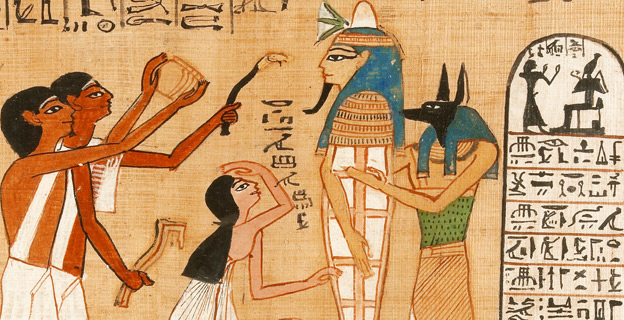

An unexpected find by Egyptologist, John Taylor, has made a remarkable impact on the piecing together of the entire, original manuscript of the ancient Egyptian tome, the Book Of The Dead.
Wikipedia says about the book:
The Book of the Dead is made up of a number of individual texts and their accompanying illustrations. Most sub-texts begin with the word ro, which can mean mouth, speech, a chapter of a book, spell, utterance, or incantation. This ambiguity reflects the similarity in Egyptian thought between ritual speech and magical power. In the context of the Book of the Dead, it is typically translated as either “chapter” or “spell”. In this article, the word “spell” is used.
At present, some 192 spells are known,though no single manuscript contains them all. They served a range of purposes. Some are intended to give the deceased mystical knowledge in the afterlife, or perhaps to identify them with the gods: for instance, Spell 17, an obscure and lengthy description of the god Atum. Others are incantations to ensure the different elements of the dead person’s being were preserved and reunited, and to give the deceased control over the world around him. Still others protect the deceased from various hostile forces, or guide him through the underworld past various obstacles. Famously, two spells also deal with the judgement of the deceased in the Weighing of the Heart ritual.
CBC News writes:
Papyrus fragments from an Egyptian funerary text known as a Book of the Dead have been discovered in the archives of the Queensland Museum in Brisbane, Australia.
“We are incredibly surprised that we had such a significant object in our collection,” museum CEO Ian Galloway told Australian press.
The discovery was made recently during a visit to the museum by British Museum Egyptologist John Taylor.
While on a tour of the Australian venue’s Egyptian collection ahead of its new exhibit Mummy: Secrets of the Tomb (which opened Thursday), Taylor noticed a familiar name — Amenhotep, a well-known ancient Egyptian head of builders — on a fragile piece of papyrus long ago conserved by Queensland Museum curators.
Upon further examination of the collection, he confirmed that the ancient scraps were from The Book of the Dead of Amenhotep, an ancient Egyptian official from approximately 1420 B.C.
Read more at cbc.ca/news
